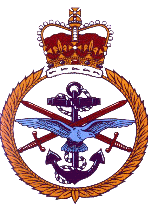





 The overall structure of Defence has maintained the existence of three separate Armed Services into which individual Servicemen and women are recruited and to which they belong throughout their military careers. What has changed is the recognition that Defence is increasingly managed on a tri-Service basis. Much development since 1964 has been focused on the central machinery for achieving this through the concentration of policy-making in the MOD Headquarters, with military and civilian staffs working in integrated hierarchies.
Today�s MOD is a fusion of old ministries: from 1946 to 1964 there were five Departments of State doing what the unified MOD does now: the Admiralty, the War Office, the Air Ministry, the Ministry of Aviation and the Ministry of Defence itself. In 1964 the first three and the MOD were amalgamated, and the defence functions of the Ministry of Aviation Supply (as it had by then become) were absorbed in 1971, when the MOD took over responsibility for supplying military aircraft and guided weapons.
The MOD produces two different sorts of integration. First, it integrates the political and the military. It links the roles and missions of the Armed Forces to the Government�s wider foreign and security policy. In terms of operations, this means dealing with the grand-strategic and military-strategic levels of planning and direction. Second, it brings together the three individual military services to work together.
The overall structure of Defence has maintained the existence of three separate Armed Services into which individual Servicemen and women are recruited and to which they belong throughout their military careers. What has changed is the recognition that Defence is increasingly managed on a tri-Service basis. Much development since 1964 has been focused on the central machinery for achieving this through the concentration of policy-making in the MOD Headquarters, with military and civilian staffs working in integrated hierarchies.
Today�s MOD is a fusion of old ministries: from 1946 to 1964 there were five Departments of State doing what the unified MOD does now: the Admiralty, the War Office, the Air Ministry, the Ministry of Aviation and the Ministry of Defence itself. In 1964 the first three and the MOD were amalgamated, and the defence functions of the Ministry of Aviation Supply (as it had by then become) were absorbed in 1971, when the MOD took over responsibility for supplying military aircraft and guided weapons.
The MOD produces two different sorts of integration. First, it integrates the political and the military. It links the roles and missions of the Armed Forces to the Government�s wider foreign and security policy. In terms of operations, this means dealing with the grand-strategic and military-strategic levels of planning and direction. Second, it brings together the three individual military services to work together.
The Secretary of State for Defence is responsible for the formulation and conduct of defence policy, and for providing the means by which it is conducted. Under current arrangements he is supported by two Ministers of State, one for the Armed Forces, dealing with operational and policy issues, and one for Defence Procurement. There is also a Parliamentary Under Secretary who deals with personnel issues and estate business among other matters.
The Secretary of State has two principal advisers: one civilian, the Permanent Under-Secretary of State, or PUS, and one military, the Chief of the Defence Staff or CDS. Under the CDS, each of the three Services has its own Chief of Staff. The CDS is the professional head of the Armed Forces in the United Kingdom and the principal military adviser to the Secretary of State and the Government. The chain of command for the planning and conduct of military operations flows from the Cabinet and the Secretary of State to CDS, and from him down to operational commanders at various levels.
The Chief of Defence Procurement (CDP) is the head of the Procurement Executive which is responsible for the development and acquisition of major weapons systems. The PE is the largest purchasing organisation within the Government.
